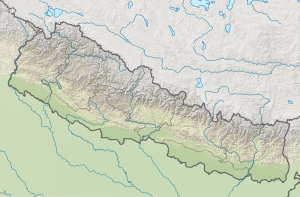| Buddhashanti बुद्धशान्ति गाउँपालिका | |
|---|---|
| Rural Municipality | |
  | |
| Coordinates: 26°43′26″N 88°03′01″E / 26.723838°N 88.050179°E / 26.723838; 88.050179 | |
| Province | Koshi Province |
| District | Jhapa |
| Wards | 7 |
| Established | 10 March 2017 |
| Seat | Budhabare |
| Government | |
| • Type | Village Council |
| • Chairperson | Mr.Manoj Prasai(NC) |
| • Vice-chairperson | Mrs. Bhawani Prasad Khatiwada (CPN-UML) |
| Area | |
| • Total | 79.78 km (30.80 sq mi) |
| Population | |
| • Total | 41,615 |
| • Density | 520/km (1,400/sq mi) |
| Time zone | UTC+5:45 (Nepal Standard Time) |
| Website | official website |
Buddhashanti (Nepali: बुद्धशान्ति गाउँपालिका) is a rural municipality (gaunpalika) out of seven rural municipality located in Jhapa District of Koshi Province of Nepal. Buddhashanti, according to Ministry of Federal Affairs and Local Development has an area of 79.78 square kilometres (30.80 sq mi) and the total population of the municipality is 41,615 as of Census of Nepal 2011.
Budhabare and Shantinagar which previously were all separate Village development committee merged to form this new local level body. Fulfilling the requirement of the new Constitution of Nepal 2015, Ministry of Federal Affairs and Local Development replaced all old VDCs and Municipalities into 753 new local level body (Municipality).
The rural municipality is divided into total 7 wards and the headquarter of this newly formed rural municipality is situated in Budhabare.
Demographics
At the time of the 2011 Nepal census, Buddhashanti Rural Municipality had a population of 41,624. Of these, 72.9% spoke Nepali, 10.9% Limbu, 2.9% Rai, 2.3% Tamang, 1.8% Dhimal, 1.5% Magar, 1.3% Newar, 0.8% Maithili, 0.8% Tharu, 0.7% Rajbanshi, 0.4% Bantawa, 0.3% Bhojpuri, 0.3% Chamling, 0.3% Sherpa, 0.2% Danwar, 0.2% Gurung, 0.2% Kisan, 0.2% Kulung, 0.2% Lepcha, 0.2% Urdu, 0.1% Hindi, 0.1% Khaling, 0.1% Majhi, 0.1% Sunwar and 0.4% other languages as their first language.
In terms of ethnicity/caste, 34.8% were Hill Brahmin, 13.1% Limbu, 11.4% Chhetri, 6.9% Rai, 6.2% Kami, 3.9% Newar, 3.7% Tamang, 3.3% Magar, 2.5% Damai/Dholi, 2.1% Dhimal, 1.1% Rajbanshi, 1.0% Tharu, 0.9% Gharti/Bhujel, 0.8% Sarki, 0.8% Sunuwar, 0.7% Gurung, 0.7% Kumal, 0.6% other Dalit, 0.6% Sanyasi/Dasnami, 0.5% Terai Brahmin, 0.4% Musalman, 0.4% Sherpa, 0.3% Danuwar, 0.3% Teli, 0.2% Kisan, 0.2% Kulung, 0.2% Lepcha, 0.2% Majhi, 0.2% Pattharkatta/Kushwadiya, 0.2% other Terai, 0.1% Bengali, 0.1% Chamling, 0.1% Hajjam/Thakur, 0.1% Halwai, 0.1% Khawas, 0.1% Musahar, 0.1% Yakkha and 0.9% others.
In terms of religion, 75.8% were Hindu, 13.8% Kirati, 6.1% Buddhist, 2.5% Christian, 0.6% Prakriti, 0.5% Muslim and 0.7% others.
In terms of literacy, 77.4% could read and write, 2.3% could only read and 20.3% could neither read nor write.
References
- ^ "स्थानीय तहहरुको विवरण". www.mofald.gov.np/en. MoFALD. Archived from the original on 31 August 2018. Retrieved 16 April 2018.
- "CITY POPULATION – statistics, maps & charts". www.citypopulation.de. 8 October 2017. Retrieved 16 April 2018.
- ^ "परिचय" [Introduction]. www.buddhashantimun.gov.np (in Nepali). Buddhashanti Rural Municipality. Retrieved 16 April 2018.
- NepalMap Language
- NepalMap Caste
- NepalMap Religion
- NepalMap Literacy
External links
| Jhapa District | ||
|---|---|---|
| Headquarters: Bhadrapur | ||
| Rural municipalities |  | |
| Municipalities | ||
| Municipalities of Koshi Province | |
|---|---|
| Metropolitan cities | |
| Sub-metropolitan cities | |
| Largest municipalities (by population) | |
| Largest Rural municipalities (by population) | |
| Koshi Province articles | ||
|---|---|---|
| Capital: Biratnagar | ||
| History | ||
| Geography | ||
| Economics | ||
| Politics and Government | ||
| Administration | ||
| Protected Areas | ||
| Largest Rural Municipality | ||
| Largest Municipality | ||
This article about a location in the Jhapa District of Nepal is a stub. You can help Misplaced Pages by expanding it. |